|
Shovel on a Little More Coal
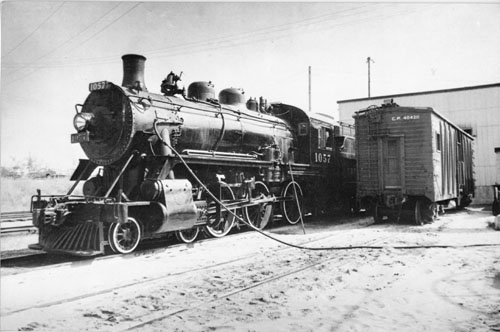
NUMBER 1057 REPOSES AT HER SERVICING POINT AT OTTAWA'S National Museum of Science and Technology, the engine's base of operations during the summer of '73. The picture is courtesy of Bruce duFresne. Should you ever decide to join the Railway Branch,
Surface Transport Administration, Department of Transport, Government of
Canada, you can expect to become involved in a variety of undertakings, most
of which are related to a greater or lesser degree to railways.
Canadian Rail, June 1974.
But who could have imagined that an apparently innocent telephone call in mid-April 1973 would have projected me into the steam locomotive procurement and operation business? It was unbelievable, but it was a fact. A steam locomotive was required for operation in the Ottawa, Canada area by July 1, 1973 and I was expected to procure it. When I became involved, the terminal date was about 75 days away. In the early 1970s, steam locomotives were like gold: precious and scarce. But there were and are a number of diligent modern-day prospectors like Mr. Duncan du Fresne of the Air Traffic Control Section, Air Administration, Department of Transport. You might think that a person working for Air Traffic Control would not know anything about railways but, in Dunc's case, the exact opposite is the case. Dunc could tell me that a group in Toronto had an operating steam engine, which just might be available for the proposed Ottawa operation. Taking a chance, I made a telephone call and, within a short time, I had determined that Ontario Rail Association did have an ex-Canadian Pacific Railway 4-6-0 locomotive, Number 1057, which was available for the summer season. Having found the proverbial "needle in the haystack", I assumed that my part of this unusual project was completed. How wrong I was". Next thing I knew, I was "loaned" to the National Capital Commission of Ottawa to co-ordinate the operation of a steam-hauled passenger train in the Ottawa area during the summer of 1973 and to resolve the thousand-and-one problems that were sure to be encountered. Originally, it had been planned to operate the steam-hauled train over 19.7 miles of CP RAIL's Maniwaki Subdivision, from Ottawa to Wakefield, Quebec. This is a very scenic line which parallels the beautiful Gatineau River for much of its distance. Negotiations were proceeding smoothly, when heavy rains and a mud slide severed the line to Wakefield and it therefore became necessary to select an alternate route for the summer operation. The new route was over the Carleton Place Subdivision of CP RAIL, 27.7 miles west to Carleton Place, Ontario. The use of this line would involve operation in CTC territory to Bells Junction. Engine 1057, identified as belonging to the Credit Valley Railway, had to be stored and serviced in Ottawa between weekend trips and arrangements were concluded with the National Museum of Science and Technology, represented by Mr. John Corby, Curator of Industrial Technology, to perform part of this service. The Museum was to be a joint partner in the scheme with the National Capital Commission. The Bytown Railway Society of Ottawa agreed to clean and service the locomotive and Duncan du Fresne's experience was to prove invaluable when it came to details of steam locomotive maintenance and operation. It is an understatement to say that I was learning - and remembering - more and more about steam locomotive operation. For example, I discovered that, in the 1970s, the high calorific coal best for use in the firebox of a steam engine, comes from West Virginia, U.S.A. Hastily, I ordered a carload. It arrived about five days before the first scheduled trip of 1057. The locomotive arrived in Ottawa via CP RAIL about a week before "The Great Day", but with her connecting and eccentric rods removed. The 175-ton locomotive had to be moved by sheer manpower to the appropriate position for installing the left-side connecting rod. That was not an easy job, but Bytown members provided the muscle to complete the task. And then, before anyone had time to flinch at the possible operating problems, "The Great Day" arrived. In the early hours of that memorable day, a wood fire was carefully laid in the firebox of 1057 at the National Museum of Science and Technology. Right then and there, the first operational problem was encountered. How extra-ordinary! No one had a match to light the kindling!. But by great good fortune, a pipe-smoking member was found and, luckily, he had a match. None too soon, the wood fire was blazing, a little coal had been added judiciously and, after a seemingly interminable and not a little agonizing interval, the black needle on the white face of the steam gauge slowly edged off the pin. The engine crew for the day's run was supplied by CP RAIL, but neither the engineer or the fireman had operated a steam locomotive for nearly 15 years. With the helpful advice of the irreplaceable Dune du Fresne, the engineer, fireman and 1057 were sure to perform flawlessly. Now I could give a sigh of relief. My part of the project - once again - seemed to be complete. It would have been, had not my own darned curiosity intervened. There was a time, a number of years ago, when I had a brief fling at working as a fireman on a British steam locomotive for a short period. This experience naturally led me to wonder if firing a steam engine in Canada in 1973 was a different sort of experience than that which I remembered. There was just one way to find out. So, on a Sunday morning in July 1973, I found myself in the cab of Number 1057, preparing to play the part of fireman under the ever watchful eye of Dune du Fresne - of the Air Traffic Control Branch. But first, what should the well-dressed Canadian steam locomotive fireman wear? I had managed to find my navy-blue British Railways overalls in the basement of my home, but my peaked BR plastic-topped cap looked a bit out of place. So I went out and bought a conventional, flimsy, blue-denim one. I had never before worn gloves when firing a steam locomotive; on all the former Great Western Railway (England) locomotives, the levers in the cab were fitted with varnished wooden handles which did not transmit the heat too much and, anyway, a few days on the shovel soon hardened up my hands. I must admit I felt a little self-conscious in my strange new cap and new leather gloves. Standing in the station at Ottawa, Number 1057 had a full head of steam and plenty of water in her boiler. Through the open fire-doors, I could see that the fire was well burned through and quite thin. It had been allowed to burn this way so that the engine would not blow off steam or make smoke while she was standing in the station. Wisps of steam arose from her valves and cylinders and periodically, the air-pump thumped and banged rhythmically. Cautiously, I added two or three scoops of coal, mostly around the back corners of the firebox and under the doors, with a little up front. The blower was turned on to disperse the resulting small amount of smoke. At the "All aboard" signal from the conductor, the engineer turned on the bell-ringing valve and cracked the throttle. There was the familiar momentary pause, as the steam pressure built up in the cylinders and then, with a soft and slightly soggy "whoosh", No. 1057 led her train slowly out from under the platform canopy into the bright sunshine, to the music of several "toots" on the whistle, which added to the general excitement. The apron and the cab floor slowly began their shifty little dance, as I stood on the deck ready for the first round of serious firing. I had that strange feeling, experienced so many times before on the footplate of an unfamiliar locomotive at the beginning of a run. I wondered if I could really fire this monster for 50-odd miles. How would she react to my firing? Could I persuade her to steam as she should? Could I judge her peculiarities well enough to keep the needle of the steam gauge and the water in the glass where they ought to be? There was no time for conjecture. We were running and there were almost 300 passengers behind the tender drawbar. Now it was "left foot on the pedal" for the firedoors. Scoop in. Scoop out. Foot off pedal. The first shovelful of coal went just under the doors, to reduce the blast of heat. After that, shovelfuls of coal around the back corners of the firebox, with a few up front. It was easier to reach the front by bouncing the scoop off the firehole, although this added to the mounting noise in the cab. Just when I was settling into the long-forgotten rhythm of firing a locomotive, Dune tapped me on the shoulder. The din in the cab was now deafening, but he did not need to speak. He just pointed to the sky visible above the tender, nearly obscured by a thick pall of black smoke. Oh Heavens! This, right in the middle of one of Ottawa's swimming-pool districts, where people are pollution-hypers! And on a Sunday morning in summer, at that! Turn on the blower quickly and let the stack clear somewhat. 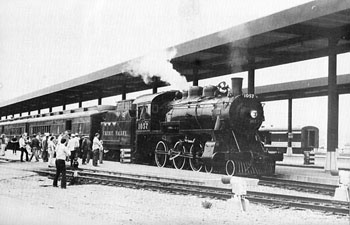
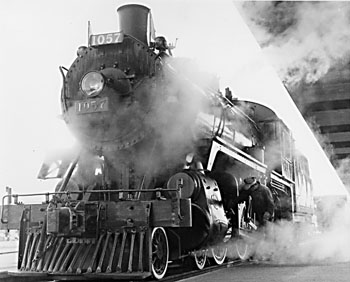
A little more water in the boiler was needed and Dune put on the injector on the fireman's side. The steam pressure dropped slightly, as the locomotive was not yet properly warmed up. But, thank goodness, the stack had cleared and we were rolling through the outskirts of Canada's capital city under the traditional white clouds of steam from the stack. I had a good look at my fire, using the scoop to deflect air through the flames, so that I could see the condition of the firebed. The next round of coal went on without making black smoke, you can bet! And so the ritual continued. A round of firing; check the stack, water glass and steam pressure. Sweep up the coal and hose down the deck. Check the stack again and it was time to get to work with the scoop. Familiar landmarks passed, but there was no time for sightseeing. I was a slave to the white-hot inferno behind the firedoors. A glimpse of the cool, slow-flowing Rideau River contrasted sharply with the deafening noise in the hot, bucking, swaying cab. Puffing through Ottawa's western suburbs, Number 1057 warmed to her task. The steam pressure was close to 200 pounds, with the injector on and a white-hot fire. Up ahead was the steepest grade on the run, at Nepean, and the fire needed almost continuous attention. I could not see more than six inches into the roaring red and white fire, yet I had to be certain exactly where each shovelful of coal should be placed. Every time my foot hit the pedal, my left side was scorched and, just about then, I discovered that if I lifted my foot from the pedal too soon, the scoop would be trapped in the firedoors! 
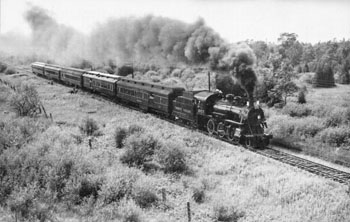
The engineer gradually brought the reverser back towards centre, reducing the cutoff, and the exhaust from 1057's stack softened, but the incessant banging, clanging and jolting in the cab persisted. Muscles, used to less strenuous activity, complained mildly, a warning, perhaps, of a future unpleasant consequence to this day's exercise. I thought that Dune would probably motion to me to shut off the injector, shortly. When he did, I would have to sacrifice the level of water in the boiler to maintain steam pressure and the fire would work down a little. But I did not know this road, and the injector stayed on. Steam pressure began to drop alarmingly and I had to hop to it with the scoop. Luckily, we had only five cars behind the tender and I was able to resurrect my fire while 1057 coasted along with the greatest of ease. A brief pause in firing allowed the breeze to cool my hot face and gave me a chance to exercise a privilege of my occupation in waving to the spectators at the overbridge at Ashton. And then, all at once, we were approaching the block signal for Carleton Place. It seemed impossible that we had come nearly 30 miles. As Number 1057 came to a stop in the station, the clanging and banging in the cab ceased, to be replaced by the monotonous whine of the turbogenerator atop the boiler. Hot, grimy and sweaty, I stood in the gangway and looked down into the sea of faces of several hundred people who had come to the station to greet us. There were old-timers with a far-away look in their eyes, remembering the days when they rode the heaving, swaying deck of an engine or listened to the far-off cry of the whistle. There were the wide-eyed youngsters, gazing in wonder at this real, live, panting steam locomotive, seeing it for the first time in their lives and just a little frightened by its black, hissing bulk. The varied expressions on all these many faces reassured me that the recreation of a little piece of Canada1s transportation history had truly been worthwhile. "Isn't it hard work, shovelling all that coal?" The ten-year-old's question snapped me out of my reverie. "It's not all that hard, once you know how," I replied, puffing out my chest - just a little. I just managed to stop myself from adding," But I don't think I would want to do this for a living!" No. In retrospect, I don't suppose I would want to do this kind of a job for a living now, but there was a time when doing the job of a locomotive fireman on an express train seemed to be all that I ever wanted, or would want to do. The return trip from Carleton Place to Ottawa helped to confirm my happy memory. It was satisfying to know that I could still do the kind of work that I had almost forgotten how to do. Of course, times have changed from the days when I first learned this trade. Steam locomotives, by and large, have disappeared and because they have dissappeared, perhaps I feel impelled to try firing one whenever the opportunity occurs. Without doubt, there will be another summer, another July and another steam engine. When this happy occasion occurs, it is quite reasonable to suppose that on a Sunday in July, I will find myself once again at a station, dressed in overalls and denim cap, with gloves and scoop, anxious to satisfy that ungovernable urge. And I am sure that the experience will be, then as now, a satisfying and rewarding one. I just hope that they won't change all the coal-burning steam locomotives to oil-burners'. If they do, I will just have to learn a new technique". 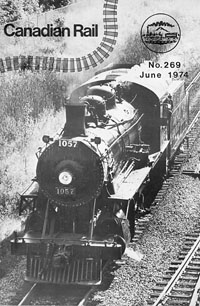
|